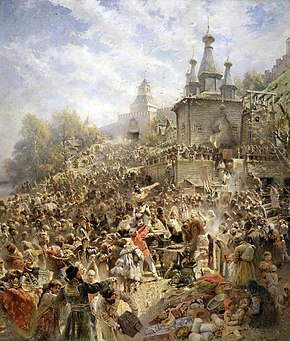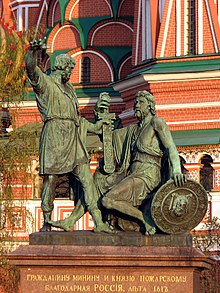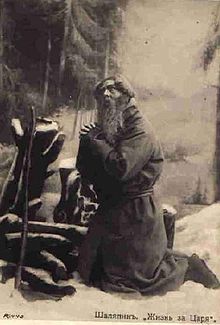Time of Troubles
This article needs additional citations for verification. (February 2021) |

The Time of Troubles (Russian: Смутное время, Smutnoe vremya), or Smuta (Russian: Смута), was a period of political crisis during the Tsardom of Russia which began in 1598 with the death of Fyodor I (Fyodor Ivanovich,[1] the last of the Rurik dynasty) and ended in 1613 with the accession of Michael I of the House of Romanov.
It was a time of lawlessness and anarchy following the death of Fyodor I, a weak and possibly intellectually disabled ruler who died without an heir. His death ended the Rurik dynasty, leading to a violent succession crisis with numerous usurpers and false Dmitrys (imposters) claiming the title of tsar.[2] Russia experienced the famine of 1601–03, which killed almost a third of the population, within three years of Fyodor's death. Russia was occupied by the Polish–Lithuanian Commonwealth during the Polish–Russian War (also known as the Dimitriads) until it was expelled in 1612.
The Time of Troubles ended with the election of Michael Romanov as tsar by the Zemsky Sobor in 1613, establishing the Romanov dynasty, which ruled Russia until the February Revolution in 1917.
Background[]

Tsar Fyodor I was the second adult son of Ivan the Terrible, the first tsar of Russia, who founded the Tsardom of Russia in 1547 as the successor of the Grand Duchy of Moscow. Fyodor's elder brother, Tsarevich Ivan Ivanovich, was the heir apparent; Fyodor was never considered a serious candidate for the Russian throne. Tsarevich Ivan was accidentally killed in anger by their father on 19 November 1581, however, making Fyodor the new heir apparent. After Tsar Ivan's death on 28 March 1584, Fyodor was crowned as the tsar three days later. The pious Fyodor took little interest in politics, ruling through Boris Godunov (his closest advisor, a boyar and the brother of Fyodor's wife, Irina Godunova). Fyodor produced one child: a daughter, Feodosia, who died at age two. When Fyodor died in January 1598, the Rurik dynasty which had ruled Russia since the ninth century ended. Godunov, a de facto regent for Fyodor, was elected his successor by the Zemsky Sobor.
Russia experienced a famine from 1601 to 1603 after extremely poor harvests, with nighttime temperatures in the summer months often below freezing.[3] The famine is believed to have been caused by the Little Ice Age, also a cause of the General Crisis; a probable cause of the Little Ice Age was the eruption of Huaynaputina in Peru in 1600.[4][5][6] Mass starvation led to the death of about two million Russians, almost a third of the population. The government distributed money and food to poor people in Moscow, leading to refugees flooding into the capital and increasing economic disorganization. Rural districts were desolated by famine and plague.
Godunov's reign was less successful than his administration under the tsar, and the general discontent was expressed as hostility towards him as a usurper. The oligarchical faction of the Russian nobility led by the Romanovs, who unsuccessfully opposed Godunov's election, considered it a disgrace to obey a boyar. Large bands of armed brigands roamed the countryside and the Don Cossacks on the frontier were restless, indicating that the central government could not maintain order.
Polish-Russian War[]
False Dmitry I[]

Conspiracies were rampant after Fyodor's death. Rumors circulated that his younger brother, Dmitry, was still alive and in hiding (despite official accounts that he had been stabbed to death at an early age, by accident or by Godunov's order). Russia's political instability was exploited by several usurpers, known as False Dmitrys, who claimed to be the tsarevich (and heir to the tsardom). False Dmitry I appeared in the Polish–Lithuanian Commonwealth in 1603, claiming to be the heir to the Russian throne.
The mysterious False Dmitry I attracted support in Russia (from those who were unhappy with Godunov) and abroad, particularly in the Polish–Lithuanian Commonwealth and the Papal States. Factions in the commonwealth saw him as a tool to extend their influence over Russia, or at least gain wealth in return for support. The papacy saw it as an opportunity to increase the influence of Roman Catholicism on the predominantly-Eastern Orthodox Russians.
Later in 1603, the commonwealth crossed the frontier with a small force of 4,000 Poles, Lithuanians, Russian exiles, German mercenaries and Cossacks from the Dnieper and Don Rivers at the beginning of the Polish–Russian War. Although King Sigismund III Vasa supported the intervention, the Poles were too preoccupied with conflicts with Sweden and the Ottoman Empire to begin another war with Russia. Some members of the szlachta supported False Dmitri I with their own forces (and money), expecting to be rewarded afterward.
After Godunov's death in 1605, False Dmitry I made a triumphal entrance into Moscow and was crowned tsar on 21 July. He consolidated power by visiting the tomb of Ivan the Terrible and the convent of Ivan's widow, Maria Nagaya, who accepted Dimitry as her son and confirmed his story. False Dimitry I was married per procura to Marina Mniszech on 8 May 1606, in exchange for promises of land grants and wealth. He converted to Catholicism, relying on Polish Jesuits and Polish nobles (who were prominent at his court) and on Mniszech's private armies.[7]
Vasili IV Shuisky[]
False Dmitry I quickly became unpopular, since many in Russia saw him as a tool of the Poles. On 17 May 1606, ten days after his marriage, Dmitry was killed by armed mobs during an uprising in Moscow after he was ousted from the Kremlin. Many of his Polish advisors were also killed or imprisoned during the rebellion.[7][8] Vasili IV Shuysky, a member of the house of Shuysky and a relative of the Rurikids, seized power and was elected tsar by an assembly of his supporters. Shuysky was a weak ruler, not satisfying the Russian boyars, Commonwealth magnates, Cossacks, or the German mercenaries who held power in Russia's conflicts. A new impostor, False Dmitry II, soon came forward as the heir. Like his predecessor, False Dmitry II enjoyed the support of King Sigismund and the Polish–Lithuanian magnates.
Shuysky signed the Treaty of Vyborg with King Charles IX of Sweden on 28 February 1609, establishing a military alliance with the Polish–Lithuanian Commonwealth's main rival. Russia agreed to cede Korela Fortress and Kexholm County to Sweden in exchange for military assistance in fighting False Dmitry II and the Poles. Sweden launched the De la Gardie campaign, commanded by Jacob De la Gardie and Evert Horn, a 5,000-person force to assist the Russians under Mikhail Skopin-Shuisky. King Sigismund declared war on Russia, hoping to gain territorial concessions and weaken a Swedish ally, and Polish troops crossed the Russian border to besiege Smolensk. Although the Swedish-Russian alliance had several victories against Dmitry, it was defeated by the Poles at the Battle of Klushino on 4 July 1610 (ending the campaign).
Second Polish occupation and anarchy[]
Shuysky was forced to abdicate by the Seven Boyars after the Battle of Klushino. Before False Dmitri II could gain the throne, Polish commander Stanisław Żółkiewski put forward a rival candidate: Sigismund's son, Prince Władysław, who was popular with pro-Polish Russian boyars. Some people in Moscow swore allegiance to him if he maintained Russian Orthodoxy and granted them privileges. They allowed Polish troops to enter the city and occupy the Kremlin, and the Seven Boyars accepted Władysław as tsar of Russia in September 1610. False Dmitry II was abandoned by most of his Polish supporters, and his campaign ended when he was killed on 11 December 1610.
Władysław's reign was interrupted when Sigismund opposed the compromise, deciding to seize the throne and convert Russia to Roman Catholicism. This aroused anti-Catholic and anti-Polish sentiment in Russia and infuriated the pro-Polish boyars who supported him. Sweden strongly disapproved of the move, fighting the Polish–Swedish wars on the Baltic coast, ending their military alliance with Russia and beginning the Ingrian War. The Swedes supported their False Dmitry III in Ivangorod. By this time, Russia was a failed state; the throne was vacant, the nobility quarreled among themselves, the Orthodox Patriarch Hermogenes was imprisoned, Catholic Poles occupied the Kremlin, Smolensk was still besieged, and Protestant Swedes occupied Novgorod. Tens of thousands died in battles and riots as bands of brigands swarmed, and Tatar raids depopulated and devastated Russia's southern borderlands.[9]
Struggle for independence[]

Popular discontent had increased by early 1611, and many sought to end the Polish occupation. Polish and German mercenaries suppressed riots in Moscow from 17 to 19 March 1611, massacring 7,000 people and setting the city on fire.[10] Although the Polish garrison in the Kremlin was besieged by the First Volunteer Army, led by Ryazan governor Prokopy Lyapunov, the poorly-armed militia failed to take the fortress. The volunteers fell into disarray, and Cossack leader Ivan Zarutsky murdered Lyapunov. Kuzma Minin, a merchant from Nizhny Novgorod, used funds donated by the city's merchants' guild to form the Second Volunteer Army (Russian: Второе народное ополчение) to oppose the Polish garrison. Minin recruited Prince Dmitry Pozharsky, a high-ranking boyar close to the Russian throne, to lead the army.
Battle of Moscow[]
In January 1612, part of the Polish army mutinied because of unpaid wages and retreated from Russia towards the Commonwealth. The Second Volunteer Army joined the other anti-Polish Russian forces in Moscow, besieging the Polish garrison remaining in the Kremlin. Well-armed and organised, the Second Volunteer Army took Yaroslavl in March 1612 and set up a Russian provisional government supported by a number of cities. Minin and Pozharsky entered Moscow in August 1612 when they learned that a 9,000-strong Polish army under hetman Jan Karol Chodkiewicz was on the way to lift the siege. On 1 September, the Battle of Moscow began; Chodkiewicz's forces reached the city, using cavalry attacks in the open and new tactics such as a mobile tabor fort. After early successes, Chodkiewicz's forces were driven from Moscow by Russian-aligned Don Cossack reinforcements. On 3 September, he launched another attack which reached the walls of the Kremlin; Moscow's narrow streets halted the movement of his troops, however, and he ordered a retreat after a Russian counter-attack.[10][11] On 22 September 1612, the Poles and Lithuanians exterminated the population of Vologda; many other cities were also devastated or weakened.[10] Although the Russian victory in the Battle of Moscow secured the city, the Polish garrison in the Kremlin remained until it ran out of supplies and capitulated on 7 November; news of the capitulation reached Sigismund at Volokolamsk, less than 30 kilometres (19 mi) away, the following day. Sigismund, on his way to assist the garrison, stopped and returned to Poland.
Michael Romanov and aftermath[]
The Zemsky Sobor elected Michael Romanov, the 16-year-old son of Patriarch Filaret of Moscow, tsar of Russia on 21 February 1613; his election is generally considered to end the Time of Troubles. Romanov was connected by marriage with the Rurikids, and reportedly had been saved from his enemies by the heroic peasant Ivan Susanin. After he took power, Romanov ordered False Dmitry II's three-year-old son hanged and reportedly had Marina Mniszech strangled to death in prison.
The Ingrian War lasted until the Treaty of Stolbovo in 1617, and the Russo-Polish War continued until the 1619 Truce of Deulino. Although Russia gained peace through treaties and preserved its independence, it was forced by Sweden and the Polish-Lithuanian Commonwealth to make substantial territorial concessions; most, however, were recovered during the next сentury. Ingria was ceded to the Swedes (who established Swedish Ingria), and Severia and the city of Smolensk were retained by the Poles. The Time of Troubles united the Russian social classes around the Romanov tsars, laying the foundation for the later reforms of Peter the Great.
Cultural allusions[]

Unity Day was held annually on 4 November to commemorate the capitulation of the Polish garrison in the Kremlin until the rise of the Soviet Union, when it was replaced by celebrations of the October Revolution. It was reinstated by President Vladimir Putin in 2005.[12]
The Time of Troubles has inspired artists and playwrights in Russia and abroad. The three most popular subjects are the Pozharsky-Minin liberation of Moscow, the struggle between Boris Godunov and False Dmitry I, and Ivan Susanin, a peasant who reportedly sacrificed himself to lead the Poles away from Mikhail Romanov:
- A Life for the Tsar (Ivan Susanin during the Soviet era), an opera by Mikhail Glinka
- Boris Godunov, a play by Alexander Pushkin
- Boris Godunov, an opera by Modest Mussorgsky based on Pushkin's play
- Two operas about False Dmitriy I: Dimitrij by Antonín Dvořák and Dimitri by Victorin de Joncières, with libretti based on Friedrich Schiller's unfinished play Demetrius
- The Monument to Minin and Pozharsky, in Red Square
- Minin and Pozharsky, a film by Vsevolod Pudovkin
- 1612, a 2007 epic film
Russian and Polish artists have painted a number of works based on the period. Chester Dunning, in his 2001 book Russia's First Civil War: The Time of Troubles and the Founding of the Romanov Dynasty, wrote that modern Russia began in 1613 with the founding of the Romanov dynasty.[13][page needed]
See also[]
References[]
Citations[]
- ^ "Britannica - Fyodor I". Encyclopedia Britannica.
- ^ Ehlers, Kai. (2009). Russland - Herzschlag einer Weltmacht. Pforte-Verlag. ISBN 978-3-85636-213-3. OCLC 428224102.
- ^ Borisenkov E, Pasetski V. The Thousand-Year Annals of the Extreme Meteorological Phenomena. ISBN 5-244-00212-0, p. 190.
- ^ "1600 Eruption Caused Global Disruption" Archived 2011-02-15 at the Wayback Machine, Geology Times, 25 Apr 2008, accessed 13 Nov 2010
- ^ Andrea Thompson, "Volcano in 1600 caused global disruption", NBC News, 5 May 2008, accessed 13 Nov 2010
- ^ "The 1600 eruption of Huaynaputina in Peru caused global disruption". Science Centric. Archived from the original on 28 April 2010.
- ^ Jump up to: a b Daniel Z. Stone. The Polish-Lithuanian State, 1386-1795. University of Washington Press, 2014. P. 140
- ^ M. S. Anderson. The Origins of the Modern European State System, 1494-1618. Routledge, 2014. P. 274
- ^ The Tatar Khanate of Crimea, allempires.net
- ^ Jump up to: a b c Sergey Solovyov, History of Russia from the Earliest Times, Vol. 8.
- ^ Nikolay Kostomarov, Russian History in Biographies of its main figures, Chap. 30.
- ^ "The Moscow Times".
- ^ Russia's First Civil War: The Time of Troubles and the Founding of the Romanov Dynasty. Pennsylvania State University Press. 2001. ISBN 0-271-02074-1. Retrieved October 16, 2010.
Sources[]
- Phillips, Walter Alison (1911). . In Chisholm, Hugh (ed.). Encyclopædia Britannica. 23 (11th ed.). Cambridge University Press. pp. 869–912. In particular, refer to pp. 896–897.
Further reading[]
- Dunning, Chester S.L. Russia's First Civil War: The Time of Troubles and the Founding of the Romanov Dynasty, Penn State Press, 2001 ISBN 0-271-02074-1
- Shubin, Daniel H. Tsars, Pseudo-Tsars and the Era of Russia's Upheavals, ISBN 978-1365414176
- Time of Troubles
- Interregnums
- Wars of succession involving the states and peoples of Europe
- 1590s in Russia
- 1600s in Russia
- 1610s in Russia
- 1598 in Russia
- 1613 in Russia